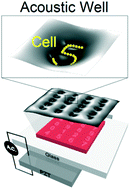Deep, sub-wavelength acoustic patterning of complex and non-periodic shapes on soft membranes supported by air cavities†
Abstract
Arbitrary patterning of micro-objects in liquid is crucial to many biomedical applications. Among conventional methodologies, acoustic approaches provide superior biocompatibility but are intrinsically limited to producing periodic patterns at low resolution due to the nature of standing waves and the coupling between fluid and structure vibrations. This work demonstrates a near-field acoustic platform capable of synthesizing high resolution, complex and non-periodic energy potential wells. A thin and viscoelastic membrane is utilized to modulate the acoustic wavefront on a deep, sub-wavelength scale by suppressing the structural vibration selectively on the platform. Using 3 MHz excitation (λ ∼ 500 μm in water), we have experimentally validated such a concept by realizing patterning of microparticles and cells with a line resolution of 50 μm (one tenth of the wavelength). Furthermore, massively parallel patterning across a 3 × 3 mm2 area has been achieved. This new acoustic wavefront modulation mechanism is powerful for manufacturing complex biologic products.



 Please wait while we load your content...
Please wait while we load your content...